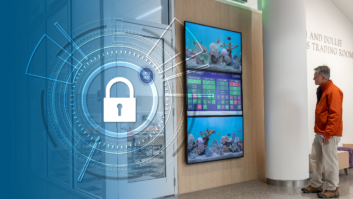MILFORD, CONNECTICUT:
When the owner of a high-end home theater sought professional help to update its components and improve its audio quality, he didn’t realize just how far cutting-edge technology and expertise could take things. As part of the process, the owner hired Connecticut-based SH Acoustics to give the room proper absorption and diffusion so as to optimize the cinematic effect. Recognizing that the room’s inherent architectural properties would create tremendous inconsistencies in the bass response from seat to seat, SH Acoustics engineered an eight-subwoofer solution using the powerful open-architecture processing of the Symetrix SymNet Edge system to effectively nullify the impact of the room modes at each of the room’s twelve seats.
“The room was built into a concrete bunker, which caused prominent room modes,” explained Marc Cote, director of design at SH Acoustics. “Moreover, the proposed design for the renovation, which originally called for two large subs at the front of the system, didn’t address bass management. Even the most advanced surround sound processors don’t begin to address such problems.” SH Acoustics’ Senior Consultant Jeremiah Flaherty served as project manager. “We used a combination of volume, equalization, delay and subwoofer placement to effectively manipulate the acoustical signature of the room for the better,” Flaherty said. The flexibility and massive processing power of three open-architecture Symetrix SymNet Edge frames gave the experts at SH Acoustics all of the tools they needed to dial in the ideal bass response, as well as proper fine-scale tuning of the system’s many full-range components.
The screen channels are traditional cinema screen channels, with left-center-right served by beefy biamped JBL units powered by QSC amplifiers. Four James Loudspeaker Power Pipes subwoofers are located at the front of the room under the stage, whereas six Pro Home Cinema subwoofers line the sidewalls for the purpose of balancing out the room response. Finally, four rbh D’Apollito loudspeakers serve each of the three rear channel positions for a total of twelve surround sound components. Because the Symetrix SymNet Edge system uses a modular I/O topology, Flaherty was able to outfit the three Edge frames with eight analog inputs (fed by the surround sound processor) and twenty-eight analog outputs.
As far as the end user is concerned, the three Symetrix SymNet Edge frames are simply magical black boxes, but using the Symetrix SymNet Composer software, Flaherty and Cote were able to use them like a comprehensive audio chemistry set. “We had complete control over each loudspeaker and subwoofer component,” said Cote. “Getting connected to the system with SymNet Composer was easy, and because the SymNet Edge system networks via the Dante protocol, dealing with eight inputs and twenty-eight outputs was no problem. All of the time-tested DSP modules from earlier-generation systems are still there, with some nice additions, such as Flex Filters.” Flaherty added, “Designing the system within SymNet Composer was straightforward, despite the complexity of the program we created. I really like having the ability to group modules with a common purpose into ‘super-modules.’ I could have four conceptually-simple super-modules, but within each might be fifty constituent modules. It’s a clean way to work.”
Apart from its simplicity, a key advantage of the Dante protocol is its almost un-measurable latency. “With earlier systems, we had to be careful to group common elements within a single processor, or the network latencies might mess with the tuning process,” said Cote. “Dante removes that concern and prevents us from chasing our tails.” With comprehensive programming that addresses every aspect of room tuning, the three SymNet Edge frames are only using 50% of their processing power, leaving plenty of room to address future requests. “You never know exactly what you’ll need until you get into a room and start tuning it,” said Cote. “With SymNet Edge, we were able to include all of the processing blocks that we thought we might possibly use, which made the tuning process much more efficient.”
He continued, “We appreciate that Symetrix is always conservative with its releases, such that there are no bugs or broken elements. Even though the SymNet Edge system is new, there was no problem in specifying it. Symetrix also provides excellent customer support, which can be critical when things get complicated and the client is watching. In addition, the audio quality of Symetrix equipment, including not only floating-point DSP and great algorithms, but also top-notch analog preamps and converters, makes its inclusion within high-end home theaters possible.”
ABOUT SYMETRIX
Sound professionals rely upon the performance, value and reliability of audio mixing, routing and processing products from Symetrix. For more information on Symetrix professional audio products, please visit
or call +1 (425) 778-7728.










